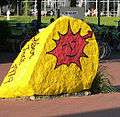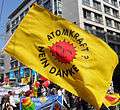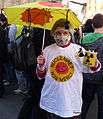Smiling Sun
The anti-nuclear badge “Nuclear Power? No Thanks" (Danish: Atomkraft? Nej tak.), also known as the “Smiling Sun,” is the international symbol of the anti-nuclear movement. It was ubiquitous worldwide in the late 1970s and the 1980s. BBC News reported in 2005 that few symbols had become "as instantly recognizable across the world.".[1] Even the nuclear power industry recognized the logo's "power and success," the BBC report said. Over 20 million Smiling Sun badges were produced in 45 national and regional languages.[2] In recent years the logo is playing a prominent role once again to raise awareness and funding for anti-nuclear groups, especially in Germany, Austria and Switzerland where opposition is growing to plans for extending operation of old nuclear reactors and constructing new ones.

The Smiling Sun logo was designed in 1975 by Danish activist Anne Lund who was part of the Danish organization OOA (Organisationen til Oplysning om Atomkraft/ Organization for Information on Nuclear Power).[3] By posing the question: “Nuclear Power?” and providing a polite answer, “No Thanks”, the logo was meant to express friendly dissent and - by questioning nuclear power - to stimulate dialogue.[2] In 2011, after the Fukushima disaster, a new version was released for renewable energy, with the statement "Renewable Energy", "Yes Please" (Danish: "Vedvarende Energi? Ja tak!") on a green background with a yellow sun.[4]
Trademark
The Smiling Sun logo is an internationally registered trademark.[5][6][7] The purpose of the trademark is to protect against alteration and prevent use by commercial and partisan political interests. Anti-nuclear groups may apply for user rights to the OOA Fund in Denmark.[8] An online shop sells Smiling Sun merchandise in 50 different languages.[9] The Italian political parties Federation of Green Lists and Federation of the Greens have licensed use of the symbol for their party electoral materials and logos.
Gallery
See also
References
- Winterman, Denise (1 December 2005). "The other smiley". BBC News Magazine.
- "The Smiling Sun".
- "The Origin of the Anti-Nuclear Emblem: 'We Wanted a Logo that Was Cheerful and Polite'". Spiegel Online. 12 July 2011.
- "Renewable Energy". smilingsun-shop.org. OOA Fonden. Retrieved 1 May 2016.
- smilingsun.org: Logo Protection - Copyright and Trademark Registration
- U.S. trademark registration
- Office for Harmonization in the Internal Market: trademark registration N⁰ 004193091
- smilingsun.org: Licensing - Rights available for NGOs and Private Commercial Undertaking
- SmilingSun-Shop


